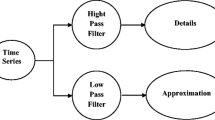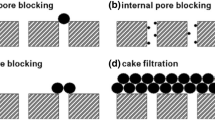Abstract
Although traditional artificial neural networks have been an attractive topic in modeling membrane filtration, lower efficiency by trial-and-error constructing and random initializing methods often accompanies neural networks. To improve traditional neural networks, the present research used the wavelet network, a special feedforward neural network with a single hidden layer supported by the wavelet theory. Prediction performance and efficiency of the proposed network were examined with a published experimental dataset of cross-flow membrane filtration. The dataset was divided into two parts: 62 samples for training data and 329 samples for testing data. Various combinations of transmembrane pressure, filtration time, ionic strength and zeta potential were used as inputs of the wavelet network so as to predict the permeate flux. Through the orthogonal least square alogorithm, an initial network with 12 hidden neurons was obtained which offered a normalized square root of mean square of 0.103 for the training data. The initial network led to a wavelet network model after training procedures with fast convergence within 30 epochs. Futher the wavelet network model accurately depicted the positive effects of either transmembrane pressure or zeta potential on permeate flux. The wavelet network also offered accurate predictions for the testing data, 96.4 % of which deviated the measured data within the ± 10 % relative error range. Moreover, comparisons indicated the wavelet network model produced better predictability than the back-forward backpropagation neural network and the multiple regression models. Thus the wavelet network approach could be employed successfully in modeling dynamic permeate flux in cross-flow membrane filtration.
Similar content being viewed by others
References
Al-Abri, M.; Hilal, N., (2008). Artificial neural network simulation of combined humic substance coagulation and membrane filtration. Chem. Eng. J., 141 (1-3), 27–34 (8 pages).
Aydiner, C.; Demir, I.; Yildiz, E., (2005). Modeling of flux decline in crossflow microfiltration using neural networks: The case of phosphate removal. J. Membr. Sci., 248(1–2), 53–62 (10 pages).
Billings, S. A.; Wei, H. L., (2005). A new class of wavelet networks for nonlinear system identification. IEEE T. Neural Networ., 16 (4), 862–874 (13 pages).
Bowen, W. R.; Jones, M. G.; Yousef, H. N. S., (1998). Prediction of the rate of crossflow membrane ultrafiltration of colloids: A neural network approach. Chem. Eng. Sci., 53 (22), 3793–3802 (10 pages).
Bowen, W. R.; Mongruel, A.; Williams, P. M., (1996). Prediction of the rate of cross-flow membrane ultrafiltration: A colloidal interaction approach. Chem. Eng. Sci., 51 (18), 4321–4333 (13 pages).
Brindle, K.; Stephenson, T., (1996). The application of membrane biological reactors for the treatment of wastewaters. Biotech. Bioeng., 49 (6), 601–610 (10 pages).
Chattopadhyay, S.; Bandyopadhyay, G., (2007). Artificial neural network with backpropagation learning to predict mean monthly total ozone in Aros, Switzerland. Int. J. Remote Sens., 28 (20), 4471–4482 (12 pages).
Chellam, S., (2005). Artificial neural network model for transient crossflow microfiltration of polydispersed suspensions. J. Membr. Sci., 258(1–2), 35–42 (8 pages).
Chen, H. Q.; Kim, A. S., (2006). Prediction of permeate flux decline in crossflow membrane filtration of colloidal suspension: a radial basis function neural network approach. Desalination, 192 (1-3), 415–428 (14 pages).
Cheng, L. H.; Cheng, Y. F.; Chen, J. H., (2008). Predicting effect of interparticle interactions on permeate flux decline in CMF of colloidal suspensions: An overlapped type of local neural network. J. Membr. Sci., 308(1–2), 54–65 (12 pages).
Cinar, O.; Hasar, H.; Kinaci, C., (2006). Modeling of submerged membrane bioreactor treating cheese whey wastewater by artificial neural network. J. Biotech., 123 (2), 204–209 (6 pages).
Craven, P.; Wahba, P., (1978). Smoothing noisy data with spline functions: Estimating the correct degree of smoothing by the method of generalized cross-validation. Numer. Math., 31 (4), 377–403 (27 pages).
Curcio, S.; Calabro, V.; Iorio, G., (2006). Reduction and control of flux decline in cross-flow membrane processes modeled by artificial neural networks. J. Membr. Sci., 286(1–2), 125–132 (8 pages).
Daubechies, I., (1992). Ten lectures on wavelets. SIAM, Philadelphia, 11–17 (7 pages).
Defrance, L.; Jaffrin, M. Y.; Gupta, B.; Paullier, P.; Geaugey, V., (2000). Contribution of various constituents of activated sludge to membrane bioreactor fouling. Biores. Tech., 73 (2), 105–112 (8 pages).
Dornier, M.; Decloux, M.; Trystram, G.; Lebert, A., (1995). Interest of neural networks for the optimization of the cross-flow filtration process. LWT. Food Sci. Tech., 28 (3), 300–309 (10 pages).
Elzo, D.; Huisman, I.; Middelink, E.; Gekas, V., (1998). Charge effects on inorganic membrane performance in a cross-flow microfiltration process. Colloid Surf. Physicochem. Eng. A., 138(2–3), 145–159 (15 pages).
Faibish, R. S.; Elimelech, M.; Cohen, Y., (1998). Effect of interparticle electrostatic double layer interactions on permeate flux decline in cross-flow membrane filtration of colloidal suspensions: An experimental investigation. J. Colloid Interf. Sci., 204 (1), 77–86 (10 pages).
Haykin, S., (1999). Neural networks: A Comprehensive Foundation. 2nd. Ed., Prentice Hall, 183-197.
Huisman, I. H.; Dutre, B.; Persson, K. M.; Tragardh, G., (1997). Water permeability in ultrafiltration and microfiltration: Viscous and electroviscous effects. Desalination, 113 (1), 95–103 (9 pages).
Li, Q. L.; Elimelech, M., (2004). Organic fouling and chemical cleaning of nanofiltration membranes: Measurements and mechanisms. Environ. Sci. Tech., 38 (17), 4683–4693 (11 pages).
Liao, B. Q.; Kraemer, J. T.; Bagley, D. M., (2006). Anaerobic membrane bioreactors: Applications and research directions. Crit. Rev. Environ. Sci. Tech., 36 (6), 489–530 (42 pages).
McDonogh, R. M.; Fane, A. G.; Fell, C. J. D., (1989). Charge effects in the cross-flow filtration of colloids and particulates. J. Membr. Sci., 43 (1), 69–85 (17 pages).
Ni Mhurchu, J.; Foley, G., (2006). Dead-end filtration of yeast suspensions: Correlating specific resistance and flux data using artificial neural networks. J. Membr. Sci., 281(1–2), 325–333 (9 pages).
Oussar, Y.; Dreyfus, G., (2000) Initialization by selection for wavelet network training. Neurocomputing, 34 (1), 131–143 (13 pages).
Oussar, Y.; Rivals, I.; Personnaz, L.; Dreyfus, G., (1998). Training wavelet networks for nonlinear dynamic input-output modeling. Neurocomputing, 20 (1-3), 173–188 (16 pages).
Priddy, K. L.; Keller, P. E., (2005). Artificial neural networks: An introduction. SPIE Press, 15-16 (2 pages).
Sahoo, G. B.; Ray, C., (2006). Predicting flux decline in cross-flow membranes using artificial neural networks and genetic algorithms. J. Membr. Sci., 283(1–2), 147–157 (11 pages).
Sanner, R. M.; Slotine, J. J. E., (1998). Structurally dynamic wavelet networks for adaptive control of robotic systems. Int. J. Contr., 70 (3), 405–421 (17 pages).
Sjoberg, J.; Zhang, Q., H.; Ljung, L.; Benveniste, A.; Delyon, B.; Glorennec, P. Y; Hjalmarsson, H.; Juditsky, A., (1995). Nonlinear black-box modeling in system identification: A unified overview. Automatica, 31 (12), 1691–1724 (34 pages).
Song, L. F., (1998). Flux decline in cross-flow microfiltration and ultrafiltration: mechanisms and modeling of membrane fouling. J. Membr. Sci., 139 (2), 183–200 (18 pages).
Tarleton, E. S.; Wakeman, R. J., (1993). Understanding flux decline in cross-flow microfiltration. I: Effects of particle and pore-size. Chem. Eng. Res. Des., 71 (4), 399–410 (12 pages).
Visvanathan, C.; Ben Aim, R.; Parameshwaran, K., (2000). Membrane separation bioreactors for wastewater treatment. Crit. Rev. Environ. Sci. Tech., 30 (1), 1–48 (48 pages).
Zhang, M. M.; Song, L. F., (2000). Mechanisms and parameters affecting flux decline in cross-flow microfiltration and ultrafiltration of colloids, Environ. Sci. Tech., 34 (17), 3767–3773 (7 pages).
Zhang, Q. H., (1992). Wavelet network: The radial structure and an efficient initialization procedure, technical report of Linkoping University, LiTH-ISY-I1423. October.
Zhang, Q. H., (1997). Using wavelet network in nonparametric estimation. IEEE T. Neural Network, 8 (2), 227–236 (10 pages).
Zhang, Q. H.; Benveniste, A., (1992). Wavelet networks, IEEE T. Neural Network, 3 (6), 889–898 (10 pages).
Zhang, X. Y.; Qi, J. H.; Zhang, R. S.; Liu, M. C.; Xue, H. F.; Fan, B. T., (2001). Prediction of programmed-temperature retention values of naphthas by wavelet neural networks. Comput. Chem., 25 (2), 125–133 (9 pages).
Author information
Authors and Affiliations
Corresponding author
Rights and permissions
About this article
Cite this article
Wei, A.L., Zeng, G.M., Huang, G.H. et al. Modeling of a permeate flux of cross-flow membrane filtration of colloidal suspensions: A wavelet network approach. Int. J. Environ. Sci. Technol. 6, 395–406 (2009). https://doi.org/10.1007/BF03326078
Received:
Revised:
Accepted:
Published:
Issue Date:
DOI: https://doi.org/10.1007/BF03326078




